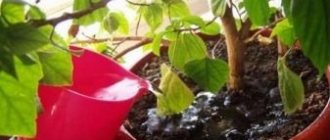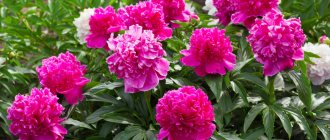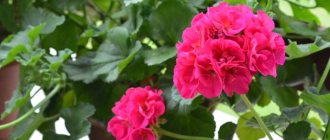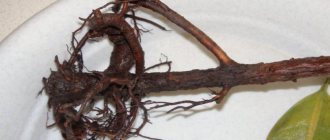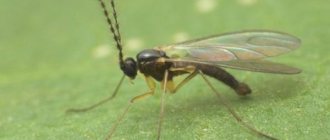Features of flowering
The orchid begins to bloom at the age of 1.5-2 years, when 5-8 leaves have formed on the stem.
Flowering too early is undesirable: it will be difficult for the plant to regain its strength and it may die.
An orchid can bloom profusely for up to 7 years. After this, flowering is reduced to 1-2 months, and it cannot be extended despite careful care. In this case, plant rejuvenation is required.
There are several phases in the development of an orchid:
- The growing season begins with the formation of a new shoot - leaves and root systems grow.
- During the dormant period, new buds and peduncles are formed.
- During the flowering phase, the plant expends energy.
- This is followed by a period of rest, recuperation and accumulation of energy for new flowering.
Typically the flowering phase lasts about three months and begins in the fall. With proper maintenance, a strong plant can produce flowering shoots even in the spring, having time to replenish its strength. Peduncles can appear three times a year. With quality care, orchids can bloom for more than 8 months.
Proper flowering of an orchid
The main reasons why begonia leaves dry out
Orchids bloom in numerous inflorescences, up to 8 dozen flowers on each plant. The range of colors and aromas is very diverse. Flowering begins at the moment when the bud is ready to bloom. It opens gradually over 24 hours, starting from the upper lateral petals.
The buds at the ends of the orchid's flower stalks bloom first. The flower grows actively for several days, after which the orchid is considered fully ripe.
Hydrogen peroxide is a popular folk remedy for treating orchids.
With proper care and favorable conditions, the flowering of Phalaenopsis lasts 3-4 months: new inflorescences open, old ones wither, after which the plant “rests” for a couple of months and again throws out buds.
What can speed up the process of buds withering?
A reduction in flowering time and rapid natural wilting of buds may depend on the age of the orchid. Older plants will have buds that quickly wither. In plants of active age, accelerated wilting of buds can occur when:
- Moving a flower pot from its usual place.
- Insufficient lighting.
- Sudden temperature fluctuations.
- Close location to heating radiators in winter.
- Violation of the watering schedule.
- Excessive or low air humidity.
- Pollination of flowers by insects flying in from the street.
- Exposure to ethylene emanating from ripe bananas, apples lying next to an orchid.
Why can they fade quickly?
Among the main reasons for the falling of buds are the following::
- Insufficient light.
- Overwatering or insufficient watering.
- Insufficient air humidity.
- Finding a flower in a draft.
- Sudden change in temperature.
- Changing the place where the plant stands.
- Diseases or pests.
- Being close to fruits and vegetables that are a source of ethylene (apples, bananas and others).
When is shedding natural and when is it not?
The flowering of an orchid begins with the smooth and slow opening of a bud located closer to the end of the peduncle. First, the side and upper petals unfold, and then the lip and the entire flower open. This happens within 24 hours.
The flower lasts 2-3 days. Then it withers, dies and falls off. This is a natural process. The flower that opens first falls first. With a sudden drop, the flowers wither and fall chaotically, regardless of the beginning of the opening of the buds.
Important! To track the development of flowers, when purchasing, it is better to choose plants with barely opened buds.
Flower processing options
Why do orchid leaves wither: reasons and methods of dealing with them
One of the main reasons that an orchid can shed unopened buds is various diseases that appear as spots and bumps on the leaves: they can turn yellow and dry out. It is possible to combat them by treating flowers to prevent the development of pathologies and the proliferation of parasites on them.
Illumination of orchids with lamps
There are many types of pest treatment products on sale, both special chemicals (including numerous fungicides against fungal infections) and biological products and organic compounds. In addition, you can use centuries-old folk floriculture experience.
Chemicals
These are means of rapid and very effective response. They are divided into 4 hazard classes, they must be used strictly for their intended purpose and be sure to follow the dosage, otherwise you can harm both yourself and your green pet. The most popular among orchid lovers are such preparations as:
- "Fitoverm";
- "Inta-Vir";
- "Aktara";
- "Tanrek";
- "Confidor".
More effective, but also more toxic are Actellik, Karbofos, Vertimek.
"Fitoverm" - a chemical preparation for treating orchids
The fungicide “Fitosporin” works well against fungal infections of orchids, which can also be used for prevention during plant replanting and subsequent pruning.
Along with chemical agents, biological flower protection products are produced. Plants do not accumulate them, and pests do not develop resistance. In addition, biological agents serve to increase immunity in orchids. Flower growers recommend fast-acting drugs:
- "Bikol";
- "Bitoxibacillin";
- "Lepidocide";
- "Verticillin";
- "Aversectin S";
- "Nemabact."
"Lepidotsid" - a biological product for treating flowers
Folk remedies
If you don’t want to resort to chemistry, you can stick to folk remedies for treating flowers:
- Soap solution: from 1 liter of water and 1 tbsp. spoons of liquid soap (or grated laundry soap), which is used to wipe the stems and foliage.
Additional Information. Regular dishwashing detergent will also work.
- Tobacco tincture: for 1 liter of water, take up to 40 grams of tobacco, ground into dust, leave for 24 hours, then strain and spray Phalaenopsis from a spray bottle.
- An infusion of onion, mashed and poured with 1 liter of boiling water, leave for 7 hours and apply to the leaves and stem. The course is 3-4 days, you should not get carried away, otherwise the plant may dry out.
- Dried citrus peels (100 grams) are poured with a liter of water and infused for a couple of days; the diseased plant is sprayed with this infusion every few hours for a week. Dry orange and tangerine peels can be used to cover the soil in a pot.
- The well-known hydrogen peroxide is used to treat orchids and other indoor plants in order to disinfect foliage and substrate from germs, mites and pests.
Advice. When using this drug, moderation and caution should be observed, otherwise the plant will begin to wither before our eyes.
Why does this happen: main reasons
When an orchid quickly sheds buds and flowers, you should wonder why this is happening. It is necessary to analyze the system of caring for the plant in order to help it and protect it from death. Common reasons:
Temperature violation
Orchids are sensitive to temperature changes and drop flowers when:
- Hypothermia. Inflorescences die at temperatures below +5°C. A cold window sill in winter can cause the buds to drop.
- Overheating from direct sunlight or radiators in winter. This injures the roots and dries out the soil.
- Sudden changes in temperature. A decrease of more than 4°C is a signal of the end of the flowering period.
- Drafts and excessive ventilation.
Insufficient lighting
Orchids produce buds as daylight increases. The development of buds requires more and more light. If there is not enough sunlight, the buds will fall off.
The orchid grows best on light eastern windowsills.
On southern windowsills, flowers are shaded from the direct rays of the sun. Orchids also grow on northern windows, but they require additional lighting. In cloudy winter weather, orchids are illuminated with fluorescent lamps for up to 10-12 hours of daylight.
Low air humidity
The most comfortable air humidity for a blooming orchid is at least 60%. When the humidity drops to 50%, not only the buds begin to drop, but also a general deterioration in the condition of the plant.
Humidity is increased in one of the following ways:
- Place open bowls of water next to the plant.
- In the morning, spray the leaves and roots with water.
- Set up a small fountain or automated humidifier.
- Place the pot with the orchid on a tray with damp expanded clay.
When placing the pot on a tray with expanded clay, the bottom should not touch the water to prevent rotting of the roots from waterlogging.
Improper watering
Overdrying and waterlogging the soil is detrimental to the orchid. The soil in the pot should be slightly moist, but not wet.
Presence of diseases and pests
The orchid may appear:
- Gray rot - gray spots form on the lower part of the plant. The disease can be caused by waterlogging of the soil, hypothermia or an overdose of nitrogen fertilizers.
- Root rot - manifested by browning of leaves, softening of roots, which no longer provide the plant with moisture and nutrition. They are treated with the drugs “Fundazol” and “Topsin”. Treat 2-3 times every 20 days.
- Mealybug - the foliage turns yellow, a white fluffy coating forms in the axils. The scale insects are removed with a soap solution, and then the plant is sprayed with an insecticide.
Why do unopened buds fall off on an orchid?
Any violation of the conditions for growing and caring for an orchid is fraught with a change in its usual life cycle, so it is not surprising that failure to comply with the requirements for watering, lighting, humidity levels and room temperature can lead to buds falling off. Let's take a closer look at each possible reason.
Violation of containment conditions
For flowering plants, one of the most important factors is a sufficient level of lighting, therefore, as daylight hours shorten, their decorativeness also decreases. In the summer, this problem usually does not arise, but with the onset of the cold season, it would be wiser to think about additional artificial light sources so that the total daylight hours are at least 12 hours a day. An orchid with already blooming flowers will not be affected in any way by the level of lighting in the room.
Did you know? Orchids are rightfully considered leaders in terms of seed productivity, because just one such plant can produce up to 4 million seeds.
When assessing the conditions for growing a flower, you should also pay attention to the dryness of the air in the room. Together with insufficient lighting, this is one of the most common reasons for the fall of unopened buds. During the heating season, this is caused by hot radiators or other heating systems, so it is useful to place wide containers of water next to them. You can periodically hang wet towels on the batteries themselves, which should also increase the humidity in the room. If possible, it wouldn’t hurt to use a humidifier, which will only need to be turned on a few times a day for 30–60 minutes.
Improper watering
Violation of watering can include both insufficient application of liquid and overwatering of the flower, and the latter is much more common. Excessively abundant watering of an orchid threatens to rot its root system, which causes the fall of not only buds, but also leaves. To prevent this from happening, you should focus on the condition of the top layer of the substrate: it is better to apply the next liquid only when the soil is at least 1-2 cm dry after the previous time.
Step-by-step instructions: what to do to save the plant?
To save the plant, you need to know what to do next with the orchid if all the flowers and buds have fallen off.
With blossoming flowers
- Isolate the plant from other potted crops.
- Carefully examine the leaves, axils, and root areas. If signs of disease or pests are detected, treat.
- Provide comfortable temperature conditions: 20-24°C during the day and 15-18°C at night.
- Increase air humidity if it is insufficient.
- Maintain soil moisture, avoiding overdrying or waterlogging.
- Avoid drafts.
With unopened buds
- Isolate the plant.
- Conduct a thorough inspection of all parts of the plant. If pests or signs of disease are detected, treat the orchid.
- If the pot has been moved, return it to its original place in the same position.
- If there is a lack of light, equip additional lighting with a fluorescent lamp.
- Analyze the watering schedule and adjust in cases of dehydration or overflow of the substrate.
- Provide plant nutrition, paying attention to phosphorus-potassium ingredients.
- Check the temperature.
- If the air is extremely dry, provide humidification.
What to do and how to save an orchid
If the buds of an orchid fall off en masse, then it will no longer be possible to save them.
Did you know? Orchids are considered one of the oldest families of flower crops, which appeared on Earth about 145 million years ago. Today in the world there are approximately 25 thousand species of these beautiful and delicate flowers.
However, you can still prevent a similar nuisance in the future, for which it is important to follow these steps:
- Collect all fallen buds and allow the soil in the pot to dry thoroughly, temporarily limiting the usual watering.
- Having prepared a new pot with a suitable soil substrate, replant the plant, removing in advance all damaged and rotten areas of the root system.
- Find a more suitable place for the orchid to grow and develop, especially if one of the reasons for dropping the buds was high temperature or increased dryness of the air in the room.
If all the windows in the house face the sunny side, then you should think about ways to shade the flower from direct sunlight (especially in the afternoon). Also, do not forget to take into account the mandatory absence of cold air flows (including from the air conditioner) and sufficient lighting. Eliminating the root cause of bud drop and timely replanting of a flower when the root system rots will save it from death and help normalize the flowering process.
Video: why buds turn yellow and fall off
The use of folk and chemical remedies for prevention
To extend the flowering period, gardeners use home remedies.
Attention! All folk fertilizers are used in solutions of low concentration. Their shelf life is less than a week.
Banana peel infusion
Banana peel contains substances useful for the formation of flower stalks.
Fertilizer preparation:
- The dried peel of one banana is crushed.
- Pour the mixture with one liter of warm water and leave for 2-3 days.
- The mixture is filtered and diluted with settled warm water in a ratio of 1:2.
- The orchid is carefully watered with the resulting infusion.
Onion peel decoction
Onion fertilizer stimulates the formation and growth of flower ovaries.
Onion fertilizer is prepared:
- The peel of one onion is poured with a glass of water.
- Boil for 10 minutes over low heat.
- Leave for 1-2 hours, filter.
- The flowers are watered with a decoction diluted with water to a light shade at room temperature.
Falling flowers
It happens that as soon as the orchid begins to bloom, it drops its flowers. This sad situation has many reasons which may be as follows:
Priming
Poor quality soil, or its aging, which is accompanied by the formation of a lump around the roots, leads to a decrease in the level of aeration. This, in turn, entails a lack of nutrients, after which the orchid’s flowers wither. This problem can be solved very simply - carefully monitor the condition of the flower and check the quality of the substrate.
Watering
The flowering period of an orchid is a time for changing the moisture regime. The watering level should be slightly reduced, even compared to the budding period. Otherwise, the flowers dry out. The watering regime is closely related to the level of air humidity. If the psychrometer (a device for measuring air humidity) gives a number below 50%, then an excellent solution would be to install an open source of water near the flower.
In addition, you can use the spraying method. Although the method is fraught with problems with the inflorescences due to the possibility of their rotting, it allows you to maintain the required level of humidity.
Lighting
Light plays a vital role in preserving and prolonging the flowering period of an orchid. As already noted, this family is very sensitive to the sun's rays and their intensity. Lack of sunlight will cause all the flowers to be dropped.
Rules for watering and fertilizing
When flowers fall off due to flooding of the plant, this means that the root system is damaged . The orchid should be replanted, while treating the roots (remove damaged areas and disinfect). After this, do not water for about 10 days, and then carefully follow the watering schedule - once a week, allowing the substrate to dry.
The flooded orchid should first be replanted.
If replanting is not carried out, then the flooded plant, which has lost its color, should first be dried and then gradually introduced to the correct watering regime.
When shedding flowers from drying out soil, the orchid is first soldered by immersing the pot in a vessel with water , and then the watering schedule is normalized.
The same rules apply to fertilizing. If an orchid has dropped its flowers due to overfeeding, then you should try to wash out excess fertilizer from the soil or replace the substrate.
CAREFULLY! After replanting a plant that has stopped flowering due to excessive fertilization, fertilizing should not be applied for 3 to 6 months.
The lack of nutrition that led to the fall of the buds should be replenished gradually. It is necessary to adjust the feeding schedule and apply it once a month with watering, using half the dose indicated on the package.
The main reasons why phalaenopsis buds fall off and what to do?
During the flowering period , with a sharp drop of buds and already blooming flowers, it is worth paying attention to the phalaenopsis itself. A question that many orchid lovers ask is: why do the flowers fall off?
There may be several reasons why a flower behaves this way Almost all of them boil down to the fact that the trunk was not properly cared for.
It is possible to prevent and avoid this, but first you need to find out the cause .
Withering and falling of buds and flowers in phalaenopsis can occur for the following reasons :
- Natural aging of the trunk , in which the plant is simply unable to fully carry out the flowering process. Neither regular fertilizing nor proper watering can help;
Before purchasing a substrate for an orchid, make sure of its quality, otherwise the flower may die.
In winter, you should not place the orchid on the windowsill; this can lead to hypothermia of the flower due to drafts.
Methods for preventing and saving peduncles
To prevent the orchid from losing its buds and flowers, you need to install it in a permanent place immediately after purchase. The best window for her would be on the northwest side. The temperature in the room should not be lower than 22 degrees. In this case, you need to monitor the humidity.
By providing the flower with such conditions, you will be able to enjoy the beauty of its inflorescences for a long time. And subsequent flowering will not take long.
And if the flowers have already begun to fade, what should you do? First of all, check whether watering is required. Then determine the correspondence between temperature and humidity. Make sure there is enough daylight.
If everything is in order, then inspect the root system and leaves - perhaps pests or diseases are to blame.
How to properly care for orchids?
Is it possible to provide such a capricious flower with suitable conditions for flowering in an apartment? Yes, and it is not as difficult as it might seem at first glance. Hybrid varieties are much less demanding on growing conditions, like their ancestors, and they can easily find a suitable place.
Any orchid loves light, and they love to be on eastern windowsills.
Direct sunlight is undesirable, as it can cause leaf burns. Orchids should not be placed under air conditioners or open windows; these plants are sensitive to drafts. It is best to find a spacious window sill for it, where other plants will not block the sunlight; lush flowering will make it a real decoration of the room.
It is equally important to provide the orchid with proper watering. Its frequency depends on the characteristics of the soil. However, there is one important requirement: the orchid is watered only after the earthen clod has completely dried out. There are several ways to determine when it is time to water:
- Pay attention to the weight of the pot. Experienced gardeners are good at distinguishing by weight whether the soil has completely dried out or is still moist.
- When growing phalaenopsis in a transparent pot, pay attention to the color of the roots. If they have a bright green tint, then it is too early to water the plant. And if they become light, it’s time.
- Dip a wooden skewer into the soil in the pot and leave it in the ground for half an hour: if it becomes damp, the soil does not need to be watered yet.
- If an orchid grows in a transparent plastic pot, look at its walls: when the soil dries completely, condensation stops accumulating on them, and the soil itself becomes light. This indicates that it is time to water.
- Under no circumstances should you water your orchid with cold tap water: this creates a stressful situation for the plant, and it may begin to drop its flowers. The optimal solution for watering is settled or filtered water at room temperature, and it must be left for at least a day.
In addition to proper watering of orchids, you need to take care of caring for the roots and leaves. If the plant produces new aerial roots and they penetrate outside the pot, they do not need to be covered with soil. Old roots can only be cut after they have turned brown; they are cut back to the young green part. If the leaves become flabby, this indicates a disease of the root system, and the plant needs to be replanted. Leaves need to be wiped regularly and protected from dust.
